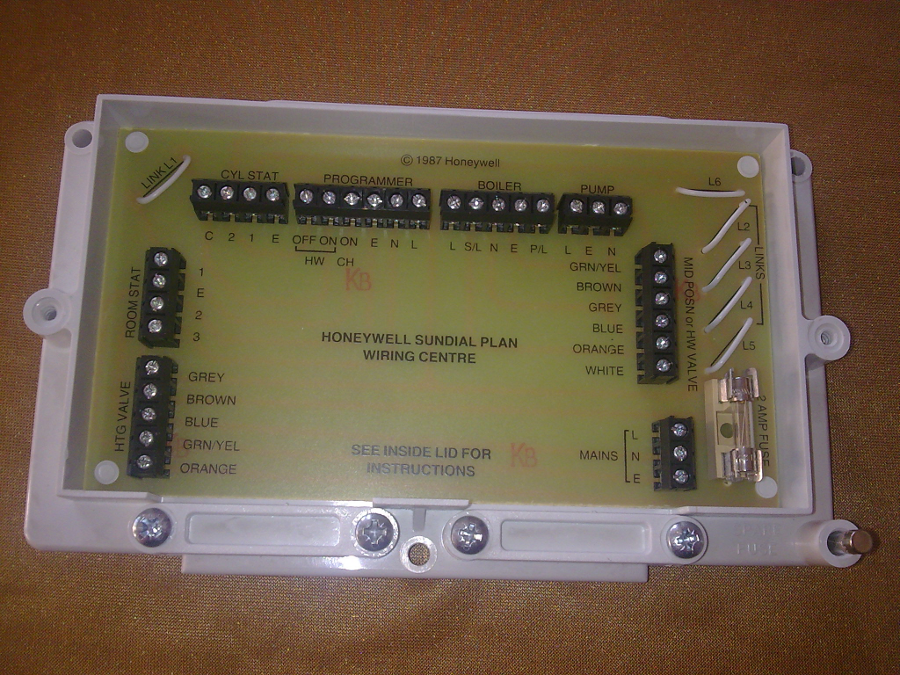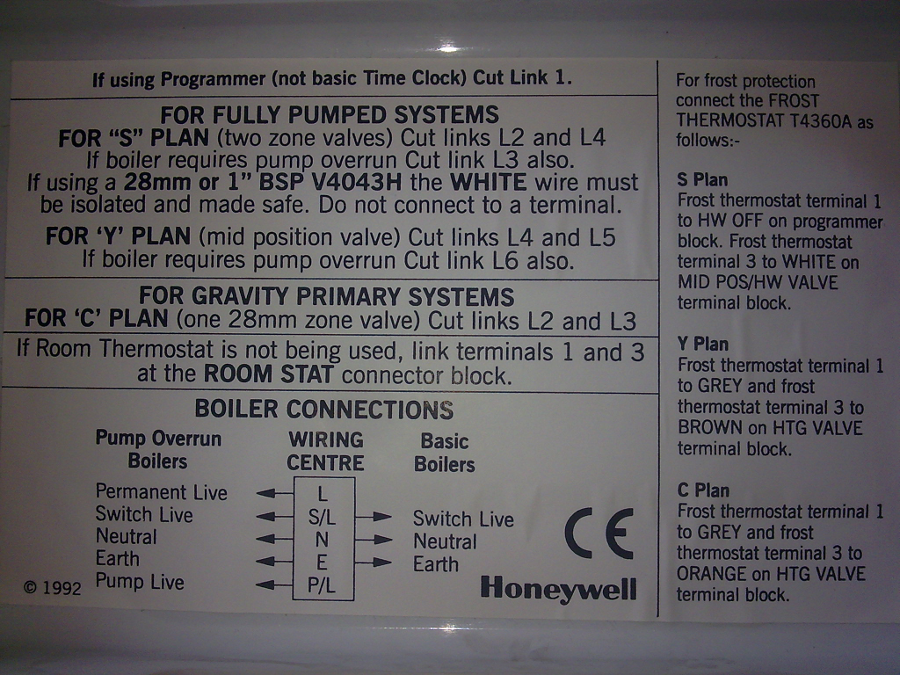The Honeywell Wiring centre 42005748-001 is nothing more than a junction box, one can't assume the person wiring has followed the Honeywell recommendations. However basic system is, the thermostat opens the zone valve and the zone valve in turn starts the boiler.
There are a few different zone valves so step one is find which type is fitted then you can work out which colour wire needs to be broken to insert the thermostat. I have only worked on an old system using zone valves once, and I will admit it was not easy, I worked with this
wiring diagram. In this case the brown/white going to 5 on the mid position valve was the connection from thermostat to central heating system, but you may not have mid position valves. The little insert showing a micro switch in the valve really caught me out. When I stripped down the valve there was not just one single switch but three micro switches so my testing to find fault was all up the creak.
I was not altering the system, I was simply looking for a fault, it turned out to be one of the micro switches inside the zone valve. It seems what had happened the switch had failed so some one had moved the zone valve manual bleed valve to latched on bleed. My son in law had tidied up the airing cupboard and unlatched the leaver. It took me all day to find the fault.
I am personally also wondering about the room thermostat. The new condensate boiler should in theory not need one. Theory is as each TRV closes the water starts to by-pass radiators so returns to the boiler hotter and hotter. The boiler then reduces flame hight until it can't reduce any further, at which point it switches off, after a set time the boiler switches on again, if it is found the water is still returning hot, it increases the set time, other wise is reduces the set time. This way the boiler should auto modify its self to follow the TRV's.
Adding a thermostat can upset this balanced system, however in the house I am living in not all radiators have TRV's fitted, so without a thermostat the hall, wet room, and kitchen would just get hotter and hotter. So for me to remove thermostat would mean fitting three more TRVs. The problem is the thermostat only measures hall temperature, so if hall gets too warm, then rest of house gets cold.
There are systems where each eTRV sends a signal to the hub which in turn controls the boiler, so every room is controlled independent an example is the EvoHome. However my experience with eTRV's OK cheaper version I fitted MiHome is not what I would call a 100% success. Unlike the simple wax mechanical TRV the eTRV has two sensors one for water and one for air, so in theory is should compensate for heat from the radiator. However in practice within 3°C of set temperature, but that's not much better than the standard TRV. Using a thermostat was also a failure.
I thought (and got it wrong) keep the thermostat away from radiator out of the draft and it should work well, however hind sight is good, it simply took too long for heat from radiator to reach the thermostat, by time thermostat had turned off the room near radiator was a good few degrees too hot, even though the boiler was off, heat stored in the radiator and room was still making its way over to thermostat, so set at 20°C with a 0.5°C differential the thermostat was showing 18 ~ 24°C with the hysteresis caused by time heat needed to travel from radiator to thermostat. Cure was to mount thermostat close to radiator and set it a little high to compensate, in other words doing the same as a TRV.
To my mind every room has two ideal temperatures, one temperature to use room, and second temperature so it does not take too long to heat up when ready to use and stop freezing. So lets say 20°C when in use 16°C in stand-by. The standard TRV will hold the room at 20°C, the eTRV should allow the two temperatures, but the main word is "Should" in practice as I have found, open doors, radiators on single brick walls between the rooms, wind direction, and sun in the bay window means in practice it does not happen. At best you get within 3°C of temperature you want.
I am sure if I kicked to touch the water filled radiators and fitted Myson radiators which circulate the air and don't store the heat in the same way it could work, however my own house has a Myson and the noise as it kicks in may be OK in a living room but not a bedroom. Full hot air was not much better, still heard fan cut in, whole house had to be at same temperature, and it cost an arm and leg to run.
I am sure both my fitting two thermostats one for day and one for night, and the eTRV will never pay for themselves. I spend a lot of time and effort to get house at nice temperature, the biggest problem is the bay window, seems great, but room has always got too hot when sun comes out, room above it without bay window no problem. So think hard, is it really worth all the effort to fit a thermostat?




